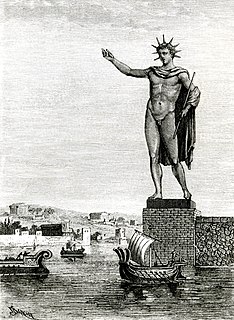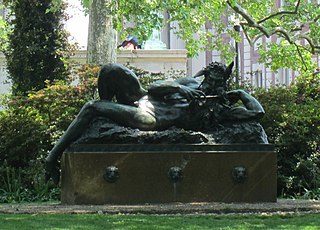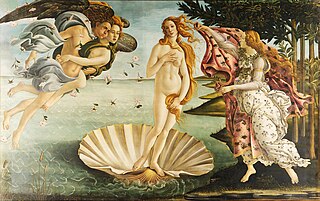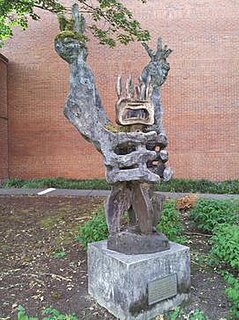 W
WAdamastor is a mythological character created by the Portuguese poet Luís de Camões in his epic poem Os Lusíadas, as a personification of the Cape of Good Hope, symbolizing the dangers of the sea and the formidable forces of nature challenged and ultimately overcome by the Portuguese during the Discovery Age. Adamastor manifests itself out of a storm.
 W
WArgive vase painting was a regional style of Greek Geometric vase painting from the city of Argos.
 W
WAsterix at the Olympic Games is the 12th comic book album in the Asterix series. Serialized in Pilote issues 434–455 in 1968, it was translated into English in 1972. The story satirizes performance-enhancing drug usage in sports.
 W
WAthena Arms the Warrior is an 1851 sculpture by Karl Heinrich Möller, installed on Schlossbrücke in Berlin, Germany.
 W
WAthena Leads the Young Warrior into the Fight is an 1853 sculpture by Albert Wolff, installed on Schlossbrücke in Berlin, Germany.
 W
WAthena Protects the Young Hero is an 1854 sculpture by Gustav Bläser, installed on Schlossbrücke in Berlin, Germany.
 W
WAthena Teaches the Young Man How to Use a Weapon is an 1853 sculpture by Hermann Schievelbein, installed on Schlossbrücke in Berlin, Germany.
 W
WThe Birth of Tragedy from the Spirit of Music is an 1872 work of dramatic theory by the German philosopher Friedrich Nietzsche. It was reissued in 1886 as The Birth of Tragedy, Or: Hellenism and Pessimism. The later edition contained a prefatory essay, "An Attempt at Self-Criticism", wherein Nietzsche commented on this earliest book.
 W
WThe Bismarck Memorial is a prominent memorial statue in the Tiergarten in Berlin dedicated to Prince Otto von Bismarck, Minister President of the Kingdom of Prussia and the first Chancellor of the German Empire. It was sculpted by Reinhold Begas. It is one of 250 memorials to Bismarck worldwide.
 W
WThe Cádiz Memorial, also known as the "Prince Regent's Bomb", is an early 19th-century French mortar mounted on a brass monster, located in Horse Guards Parade in Westminster, London. It was first "exposed to public view" on 12 August 1816 and has been classified as a Grade II listed building since 1 December 1987. The monument was a feature of many satirical verses and cartoons in the early 19th century, mainly because the word "bomb" – pronounced "bum" – gave it an immediate association with the notoriously profligate Prince Regent's sizeable backside.
 W
WThe Colossus of Rhodes was a statue of the Greek sun-god Helios, erected in the city of Rhodes, on the Greek island of the same name, by Chares of Lindos in 280 BC. One of the Seven Wonders of the Ancient World, it was constructed to celebrate the successful defence of Rhodes city against an attack by Demetrius Poliorcetes, who had besieged it for a year with a large army and navy. According to most contemporary descriptions, the Colossus stood approximately 70 cubits, or 33 metres high – approximately the height of the modern Statue of Liberty from feet to crown – making it the tallest statue in the ancient world. It collapsed during the earthquake of 226 BC, although parts of it were preserved. In accordance with a certain oracle, the Rhodians did not build it again. John Malalas wrote that Hadrian in his reign re-erected the Colossus, but he was wrong. According to Suda, the Rhodians were called Colossaeans (Κολοσσαεῖς), because they erected the statue on the island.
 W
WEt in Arcadia ego is a 1637–38 painting by Nicolas Poussin (1594–1665), the leading painter of the classical French Baroque style. It depicts a pastoral scene with idealized shepherds from classical antiquity, and a woman, possibly a shepherdess, gathered around an austere tomb. It is held in the Louvre.
 W
WFarewell to Orpheus is an outdoor 1968–1973 bronze sculpture and fountain by Frederic Littman, installed at the Portland State University campus in Portland, Oregon, United States.
 W
WThe Flight of Europa is a bronze Art Deco sculpture created by American artist Paul Manship in 1925. Copies are held by the Indianapolis Museum of Art, the Los Angeles County Museum of Art, The Columbus Museum, Columbus, Georgia, and the Smithsonian American Art Museum. It depicts the Greek myth of Europa being abducted by Zeus in the form of a bull.
 W
WThe Great God Pan is a bronze sculpture by American sculptor George Grey Barnard. Since 1907, it has been a fixture of the Columbia University campus in Manhattan, New York City.
 W
WIcarus, also known as Icarus III, is an outdoor 1973 sculpture depicting the Greek mythological figure of the same name by Michael Ayrton, installed in Old Change Court in the City of London, in the United Kingdom.
 W
WIn the Time of Gods is the eighth studio album by Dar Williams. It was released April 17, 2012 on Razor & Tie, the label that has released almost all of her albums.
 W
WIonic vase painting was regional style of ancient Greek vase painting.
 W
WThe Lovejoy Columns, located in Portland, Oregon, United States, supported the Lovejoy Ramp, a viaduct that from 1927 to 1999 carried the western approach to the Broadway Bridge over the freight tracks in what is now the Pearl District. The columns were painted by Greek immigrant Tom Stefopoulos between 1948 and 1952. In 1999, the viaduct was demolished but the columns were spared due to the efforts of the architectural group Rigga. For the next five years, attempts to restore the columns were unsuccessful and they remained in storage beneath the Fremont Bridge.
 W
WWith the rediscovery of classical antiquity in the Renaissance, the poetry of Ovid became a major influence on the imagination of poets and artists, and remained a fundamental influence on the diffusion and perception of Greek mythology through subsequent centuries. From the early years of the Renaissance, artists portrayed subjects from Greek mythology alongside more conventional Christian themes. Among the best-known subjects of Italian artists are Botticelli's Birth of Venus and Pallas and the Centaur, the Ledas of Leonardo da Vinci and Michelangelo, and Raphael's Galatea. Through the medium of Latin and the works of Ovid, Greek myth influenced medieval and Renaissance poets such as Petrarch, Boccaccio and Dante in Italy.
 W
WIn ancient Greek civilization, Nike was a goddess who personified victory. Her Roman equivalent was Victoria.
 W
WPrometheus is an outdoor 1958 cast iron sculpture depicting the mythological figure Prometheus by Jan Zach, installed north of the Jordan Schnitzer Museum of Art on the University of Oregon campus in Eugene, Oregon, in the United States.
 W
WPseudo-Chalcidian vase painting is an important style of black-figure Greek vase painting, dating to the 6th century BC.
 W
WThe Rush of Green, also known as Pan or The Bowater House Group, was the last sculpture completed by Jacob Epstein before his death at his home in Hyde Park Gate on 19 August 1959. The sculpture group includes a long-limbed family – father, mother, son and dog – rushing towards Hyde Park, encouraged by the Greek god Pan playing his pipes. It was cast in bronze posthumously and installed in 1961 on a plinth separating the carriageways of Edinburgh Gate beneath Bowater House. The sculpture was removed when Bowater House was demolished in 2006 and reinstalled near the building which replaced it, One Hyde Park, in 2010. The sculpture was granted a Grade II listing in January 2016.
 W
WThe Shaftesbury Memorial Fountain, popularly but incorrectly known as "Eros", is a fountain surmounted by a winged statue of Anteros, located at the southeastern side of Piccadilly Circus in London, England. Moved after the Second World War from its original position in the centre of the circus, it was erected in 1892–93 to commemorate the philanthropic works of The 7th Earl of Shaftesbury, the Victorian politician and philanthropist, and his achievement in replacing child labour with school education. The fountain overlooks the south-west end of Shaftesbury Avenue, also named for the Earl.
 W
WSocrates Drank the Conium was the 1971 debut album of the Greek rock band of the same name. It has more psychedelic- and blues-influenced tracks than their following albums. The work on this album is similar to that of musicians like Jimi Hendrix and Eric Clapton.
 W
WThe Songs of Bilitis is a collection of erotic, essentially lesbian, poetry by Pierre Louÿs published in Paris in 1894. Since Louÿs claimed that he had translated the original poetry from Ancient Greek, this work is considered a pseudotranslation.
 W
WTalos No. 2 is an outdoor 1959–1977 bronze sculpture created by the American artist James Lee Hansen. It is located in the Transit Mall of downtown Portland, Oregon, in the United States.
 W
WThere is a wide range of ways in which people have represented the Trojan War in popular culture.
 W
WWoodstock Mural is a mural designed by artist Mike Lawrence, painted on the west side of the New Seasons Market store in the Woodstock neighborhood of Portland, Oregon, in the United States. The painting has three sections, each representing a theme: commerce, education, and the outdoors. It depicts figures adorned with symbolism related to characters in Greek mythology, including Hermes, Athena, and Demeter, along with local businesses and local landmarks such as the neighborhood farmers' market, Grand Central Bakery, Portland Fish Market, Woodstock Park, and the Woodstock Library.